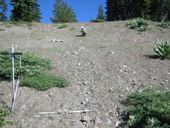Highlight
Methods used to create ski runs affect their environmental impact
Achievement/Results
UC Davis graduate student Jennifer Burt and faculty member Kevin Rice studied methods of creating ski runs in the northern Sierra Nevada and found that methods used to create ski runs differ in their effects on soil characteristics and plant diversity.
“Cleared” runs are created by cutting and removing tall woody vegetation as needed to create open pathways for skiing, but leaving the top layers of soil and their existing seed bank largely intact. “Graded” runs are cleared and then also machine-graded to remove tree stumps, boulders and surface irregularities. The grading process also removes much of the topsoil and most of the vegetation.
Burt and Rice found that cleared runs are functionally similar to adjacent forests in terms of plant abundance and diversity, and soil depth and fertility. In contrast, graded ski runs were distinct from both cleared ski runs and reference forests in plant community composition and diversity, soil physical characteristics and erosion potential, and soil fertility and potential productivity. These differences indicate that grading alters ecosystem services and function, with potentially far-ranging impacts.
Graded runs contain fewer irregularities and enable ski resorts to open 1-2 weeks earlier in the season. However, the economic benefit may be offset by increased summer maintenance costs due to activities such as erosion control.
Burt pointed out that most ski resorts operate on public lands managed by the US Forest Service, which encourages multiple uses and ecosystem protection. Changing the methods used to create ski runs may reduce the impact on the environment while minimizing adverse effects.
Address Goals
Downhill ski areas in the US provide recreation and bring revenue to the surrounding region, yet are situated in fragile high-elevation ecosystems. Most studies of the environmental impacts of ski areas have focused on alpine regions in Europe; virtually none have examined compared the ecology of ski runs relative to adjacent reference forests. Thus, the work by Burt and Rice represents a novel contribution to the ecology of ski slopes located in forested regions. Further, it provides guidance to managers of public lands about methods of creating ski runs that minimize the environmental impact of construction methods.
The publication has received considerable attention from the media, and Burt has spoken to news outlets both in the US and Europe about the research and its implications.
J. W. Burt and K. J. Rice, Ecological Applications, 19(8), 2009, pp. 2242-2253








